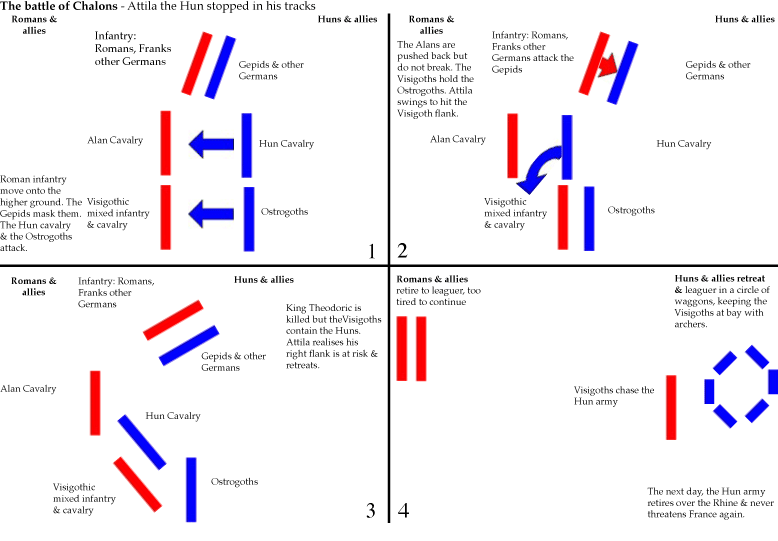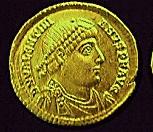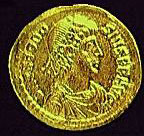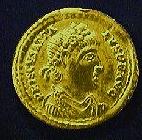 |
Patrick Delaforce & Ken Baldry'The Delaforce Family History'
|
Chapter 43
'A man may marry his widow’s sister' well-known conundrum
Early Goths
|
In the spirit of "1066 & all that", school-taught history (at least in Britain) assumes the Roman Empire to have been a "good thing", perhaps because of the evidence of sanitation & bathing, cleanliness being next to godliness in the Victorian liturgy. That the great unwashed or less thoroughly washed outside the Empire's boundaries may have had nations, laws, traditions & pride did not stop pedagogues lumping them together as being an amorphous mass of barbarians. We were taught that the barbarians caused the Romans 'trouble', whereas an examination of the position of Italy & the barbarian nations on the map shows that it was the barbarians who were troubled by the Romans trying to impose their ways on them. A student of modern history might comment, 'no change there, then'. The Germanic nations beyond the Roman Rhenish & Danubian frontiers did manage to maintain those frontiers for centuries. Attempts by the Roman armies to subdue them had one of two results: either the Germans melted away into their impenetrable forests, leaving the Romans punching thin air or they inflicted military defeats on them, most famously by Hermann in AD 9 when three legions under Quintilius Varus were reduced to 80 survivors, out of the 15,000, who confidently crossed the Rhine. The one exception was the major effort by the Emperor Trajan to deal with the strong kingdom of the Getians in what is now Romania & then, Dacia. While Trajan managed to conquer this unitary state, first knocked into a coherent shape by 44BC by King Burebista who copied Roman forms of administration & finance, it was an expensive luxury in terms of military maintenance, had constantly shifting exposed frontiers & was eventually abandoned by the Emperor Aurelian, a severe realist, in AD271. The Romans left their language & today, the Romanians speak a Latinate rather than Germanic language, which suggests that the bulk of the inhabitants just took cover during the incursions to be discussed below. It is possible to read genealogies of the Goths & the Franks going back into incredible mists of time & these must be considered merely legendary. No doubt people with the names found did exist & their stories make work for poets & minstrels but the family trees constructed from them beggar belief. It is however, necessary to start somewhere with the earliest known Delaforce ancestors - one must nail up a plaque & say, "We were here". The Visigoth lines are complicated, not so much by the conundrum above but because a king needed to marry his predecessor’s widow, in order not to leave a political loose cannon trundling round the deck. (Visigoth kings were elected, although they usually elected the old king’s son, if he came up to scratch. This system allowed them to weed out those who did not or were too young to succeed, although they were eligible for election the next time). This widow might even be his own mother &, since people married young, still nubile. So a Visigoth queen’s children could also be her grand-children. Fortunately, this does not impact the Delaforce line but uncle-niece and aunt-nephew marriages do. The Goths seem to have originated in Southern Sweden, in the area still known as Gotland. They migrated down through Eastern Europe to Romania (the Visigoths) & the Ukraine (the Ostrogoths). Some historians think the distinction to be artificial. In practice, they all thought of themselves as Goths. However, their separate histories makes the use of the West-East terms useful. The first Visigoth we detected joining the Delaforce family, was Numabela of Cantabria. By this time (about 775), Northern Spain had been in turmoil for some time. The Moors were encroaching still & there was much shuffling of population both ways over the Pyrenees, depending on the situation. The foundations of the Kingdom of Navarre were being put in place, a Christian buttress against the Moors & also against the Kings of France. The Moors never did control Navarre for any length of time. Considering that the Goths were ‘barbarians’, how come we know who they were? Because they became Christians, albeit of the Arian tendency and had priests who wrote all this stuff down. One, Ulfilas, translated the bible into Gothic German & about one-third of that has survived, providing a useful guide to Gothic usage. However, only material relating to the time of their conversion, which came before their incursions into the Roman Empire, and onwards is likely to be reliable. The Romans kept intelligence records about the barbarians on their borders but frequently had trouble with correct naming. Those researchers who quote genealogies going back into the mists of time are relying of verbal tradition, for what that is worth. Repectable historians stick at Aoric, which is surprising, considering that the Goths first attacked the Roman Empire in force half a century before his birth, being chased back out again by those two efficient emperors, Claudius II & Aurelian (the one who gave up Dacis). We are of both the mighty BALT & the even more senior AMAL families & almost everyone mentioned below contributed to the Delaforce gene pool. Goths considered themselves descended from the gods (note the plural), so some families claimed descent from more senior gods than others. The Amal claim seems to have been recognised by other Goths & they will be the subject of a later chapter. Aoric Balt (abt 290 - 354), is the first reliably known Delaforce ancestor. He was the father of Athanaric II (abt 318 - 381), who lead the Visigoths out of Dacia (Romania) & into the Roman Empire in 376 as federates. However, the bad treatment they received at the hands of Roman officials lead to an uprising two years later. On 9/8/378 & under the command of Fritigern, who's name means 'ardent for peace', they crushed the Eastern Roman army at Adrianople, killing the Emperor Valens. These armies were still largely infantry. The notion that Gothic medieval knights on horseback defeated the Roman infantry is nothing but a romantic Victorian illusion, although the arrival of the Gothic cavalry in the middle of the battle in time to surround the Romans was the turning point. Cavalry were essential for skirmishing and pursuit and both sides used them for these purposes. However, provisioning cavalry is quite difficult, involving vast quantities of hay. It was only after this battle & having digested its lessons, that the Goths took to the horse in a big way. The new Emperor, Theodosius the Great was the last competent one to rule in the West. He suppressed the Goth revolt but had to use them as his army to reunify the empire, for which historians have given him much stick. He seems also to have been a Delaforce ancestor, see Galla Placida below. Aoric's other son, Rocesthes (abt 340 - 399) was the father of Alaric I of whom, much more below. Athanaric had two children, Athaulf (abt 355 - 415) & a daughter, who married Alaric, the son of Rocesthes. Alaric I, born about 370 at Peuce in Romania, is famous for sacking Rome in 410. There was more to him than that. He had lead the Visigoths out of Romania &, while not a particularly good general, as he was always being defeated by the Western Roman General Stilicho (himself a Vandal), he was a first class politician who always managed to extricate his army intact from those defeats and take advantage of any situation that arose. He was central to the Visigoths great 40 year migration, between their entering the Empire in 376 & settling in Aquitaine in 416. Every year, they tried to stay in one place long enough to sow & reap a harvest but it must be taken into account when following this nation on the move, that the first responsibility of the king was to ensure that, if they were 200,000 strong as is suggested, they had about 100 tons of food every day. The Roman Emperor Honorius usually receives a bad press but given the poor situation he was in, he played a weak hand quite well. But having executed Stilicho, he was no match for the Visigoth army in 409. They left Honorius holed up in Ravenna, the easily defended Roman capital but with bad communications and invested Rome itself. Alaric could not take Rome but he could suborn it & someone opened the gates on 24/8/410. Not since the Gauls in the fourth century BC had foreign boots marched in Roman streets & they had been cleared out quickly. It was the beginning of a trend. Marching South, Alaric had little time to savour his victory, dying suddenly at Lucania. He was not sick nor slaughtered but he might have been poisoned, although there is no suggestion in the record of this. Athaulf, Alaric's brother-in-law & cousin, had been busy suppressing other barbarians in Pannonia. Having restored order there, he kidnapped Galla Placida during the sack of Rome. On Alaric's death, he was elected King & made an honest woman of Galla in a spectacular Roman-style marriage. There was a son who died young after the marriage. Whether the daughter, Clothilde, actually existed is moot. Presumably, if she did, she was the product of Athaulf & Galla's three year pre-honeymoon, as the record suggests that Galla was quite happy to be kidnapped.
|
Athaulf is famous for this statement:- "It was at first my wish to destroy the Roman name and erect in its place a Gothic empire. But when experience taught me that the untameable barbarism of the Goths would not suffer them to live under the sway of law, I chose the glory of renewing and maintaining by Gothic strength the fame of Rome" but there is a certain amount of special pleading here from the husband of a Roman Emperor's daughter. The Goths had a better legal system than the Romans, who relied excessively on Imperial edicts, precedent & Common Law. His great-nephew Euric codified Gothic Law. Athaulf & Galla Placida's putative daughter, Clotilde (411? -?) married Gondahar or Gundicus of Burgundy (abt 410 - 436). Their son, Gondiuque or Gundovic (abt 430 - 473) was the father of Chilpéric II King of Burgundy (abt 455 - 492) who daughter, St. Clotilde, married Clovis the Great, King of the Franks, who features in the Merovingian chapter. This is part of our line. Gundovic also fathered Godogisel, who became King of Geneva Of Alaric’s two sons of record, Valia King of the Visigoths from 415 - 418, was a formidable warrior in his brief career. He agreed with Honorius to fight the other barbarians in Spain, which he did very effectively & returned Galla Placida to Rome, where, much to her disgust, she was married off to Constantius on 1/1/417. He had always fancied her & had been partly encouraged in his wars with Athaulf by jealousy. Constantius had a short stint as Roman emperor but died in 421. After his death, Galla continued to be a power in Roman politics. Valia may have married a Roman, as his daughter was called Flávia Valiana, although a number of Goths affected Romanised names, & she became the second wife of her uncle Theodoric (abt 390 - 451), the other son of Alaric, who succeeded Valia. Having had Valia do his fighting for him, Constantius, ordered him out of Spain but gave him Federal status which allowed him to consolidate his kingdom round Toulouse, which became the Visigoth capital for the rest of the century. This allowed the Swabians (who had split into two groups about 400, the other half remaining in the Rhine Valley) to breathe a sigh of relief in Galicia, where they still are today, later successfully resisting the Moorish invasion. The decimated Alans (a Persian tribe!) merged with the Vandals, swearing fealty to King Gunderic. As a matter of passing interest, the Vandals occupying Southern Spain included Gunderic's brother, Gaiseric (389-25/1/477), who succeeded him. Since Gaiseric held a census before they crossed into Africa, we know there were 80,000 of them. (Presumably, this included the remaining Alans). How did he ferry them over the Straits of Gibraltar? By agreement with the Romans. Before being elected Vandal King in 428, Gaiseric, who could not ride a horse because of a leg injury & needed to demonstrate his martial valour some other way, had already built the fleet which was to dominate the Mediterranean for a century. One of the most intelligent of the barbarians, Gaiseric lived for 87 years. His sack of Rome in 455 was nowhere near as damaging as some historians allege. One would admire Gaiseric if it was not for this question: his son Huneric married Theodoric's daughter but, when he later had a better offer of Emperor Valentinian III's daughter in 442, Huneric returned his wife with her nose and ears inhumanly mutilated. Realising that Theodoric’s mind might be set on reprisals, Gaiseric plotted with Attila the Hun King to encourage him to invade the Western Empire. Events were to assist him. |
|
|
Theodoric was a great general & he lead the Visigoth army in June 451 as the right wing of the allied army in the Battle of Chalons-sur-Marne lead by the Roman General Aetius, where Attila the Hun was finally defeated but it cost him his life. All credit, though, to Aetius who having previously been a hostage in Attila's court, worked extremely hard to put together this alliance & for which he was rewarded by Valentinian III by being murdered 3 years later. Attila is an ancestor, so a brief note is in order. His real name was Etzel but the Romans could not handle ‘z’, so we will continue to call him Attila Chalons was not yet the end of Attila's career but it was the turning point in pushing back the Huns rampage across two continents, despite further ravages by Attila in Italy. Although Pope Leo I claimed the credit, Attila's movement out of Italy was determined both by the lack of hay & fear of the plague. It is not the end of Attila in this book, see chapter 49 on Charlemagne but it was the end of the Huns, as his sons fought each other to a standstill. One son, Ellak, had married his daughter Acama to Ardaric, the King of the Gepids. He was an ancestor of Hildegarde, the wife of Charlemagne. The Gepids had been forced into alliance with the Huns in 375 but Atilla thought highly of Ardaric, who supplied his biggest German contingent during his raid into France & this was a way of cementing the alliance. What Acama or any of the other 'trade goods' wives in this history, thought about it, is not considered history, alas. In the event, the Gepids did well out of the collapse of the Huns. Theodoric the Visigoth's son Thorismond was at the battle & succeeded him but was murdered by his brothers Theodoric & Frederic, who re-initiated the conquest of Spain. Back in Rome, King Gundobald of Burgundy (first family tree above), became the commander of the Western Roman army from 472-3.  |
|
Euric (abt 415 - 484), another son of Theodoric & Flavia, married Ragnachilde, a Frank & he finished the conquest of Spain, which had taken 17 years. Euric, formidable both as general & politician, dismissed the myth that the Visigoth kings were Roman functionaries & ruled over the biggest Visigoth kingdom there was to be. Rather, he recruited Roman functionaries to administer his empire. The Roman Emperor Anthemius tried to put Euric down, in alliance with Riothamus, the Celtic leader of a Romano-British army who may have been the original King Arthur. Euric thrashed them both & took over more Gallic towns. He was a keen Arian christian & is credited with persecuting catholics. However, he seems merely to have made catholic worship difficult by preventing the appointment of new bishops when the old ones died. He was succeeded by his son, Alaric II (abt 458 - 507). Alaric II was interesting, as he commissioned a study to see where Roman law & Visigoth law could be reconciled into a common code, suggesting he was no barbarian. However, this came to little apart from a revision of the Visigoth Code to reassure Catholic citizens about their rights, probably because of his overthrow & another century would pass before the dual legal systems were merged. Alaric was helped because his father Euric had already codified Visigoth law. He was killed at the Battle of Vouillé by Clovis the Great King of the Franks & his fifth cousin, once removed. No one seems to know where Vouillé is. Alaric had two wives, the first an unknown woman who bore Gesalic. The second was Teodegonda Amalasunta AMAL de Verona, an Ostrogoth princess. It is time to visit the Ostrogoths in the next chapter. |
|
Contact: Ken Baldry for more information, 17 Gerrard Road, Islington, London N1 8AY +44(0)20 7359 6294 but best to e-mail him |
 Emperor Valentinian I
Emperor Valentinian I Emperor Theodosius
Emperor Theodosius Attalus
Attalus